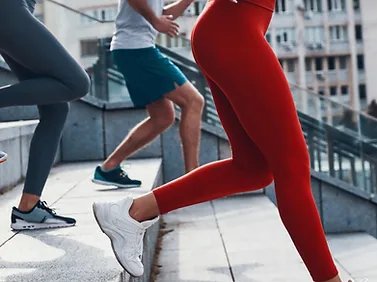Iliotibial (IT) Band Syndrome
Injury Guide

With our extensive experience working with athletes, we understand the frustration and limitations that accompany this common overuse injury. In this guide, we will delve into the symptoms, causes, and best rehabilitation strategies for Iliotibial Band Syndrome (ITBS). We hope to provide you with valuable insights that will empower you to take the first steps toward your recovery.
Symptoms:
Iliotibial Band Syndrome, commonly known as ITBS, is a prevalent condition among athletes, particularly runners and cyclists. It is characterized by pain and inflammation in the outer part of the knee or hip, caused by excessive friction between the iliotibial band (ITB) and the underlying bone. Athletes experiencing ITBS may encounter sharp or burning pain on the outside of the knee or hip during activity. Swelling or tenderness along the ITB, pain worsening when running downhill or climbing stairs, and a gradual onset of symptoms that intensify with repetitive movements are other common characteristics of ITBS.
Anatomy:
To visualize the IT Band in the model above, use the 🔍 button to search for iliotibial tract. Click+hold to rotate, Shift+click to pan. Scroll to zoom.
The ITB is a thick band of fibrous tissue that runs along the outside of the thigh, extending from the hip to the knee. It originates from the tensor fasciae latae muscle, which is located on the lateral side of the hip, and inserts into the lateral tubercle of the tibia, just below the knee joint.
The ITB serves several important functions in the lower extremity. It provides stability to the hip and knee joints during movement, especially during activities that involve running, walking, and cycling. It also acts as a tensioning mechanism, working with other hip muscles to control the position of the knee joint, particularly during weight-bearing activities.
In individuals with ITBS, the ITB becomes irritated and inflamed due to excessive friction between the band and the underlying bone structures, such as the femoral condyle or the lateral epicondyle of the knee. This friction occurs during repetitive movements, such as running or cycling, and can be exacerbated by biomechanical factors and muscle imbalances.
The implications of the ITB’s anatomy on ITBS are twofold. Firstly, the location of the ITB and its attachment points make it susceptible to repetitive stress and overuse injuries, leading to the development of ITBS. The constant rubbing and friction between the ITB and the bony structures can result in inflammation, pain, and limited range of motion.
Secondly, the tightness or tension in the ITB can impact the mechanics of the hip and knee joints. When the ITB is excessively tight or lacks flexibility, it can pull the knee joint slightly out of alignment, causing increased stress on the lateral aspect of the knee. This altered biomechanics can further contribute to the development of ITBS and may be influenced by factors such as muscle imbalances, abnormal foot pronation, leg length discrepancies, or poor running or cycling form.
Causes:
While the exact cause of ITBS may vary from person to person, several common factors contribute to its development. Understanding these causes is essential for effective rehabilitation. Overuse and training errors, such as overtraining, sudden increases in mileage or intensity, and inadequate rest and recovery periods, can lead to ITBS. Muscle imbalances, particularly weakness or imbalances in the hip muscles like the gluteus medius, can alter the mechanics of the lower extremities, increasing stress on the ITB. Additionally, biomechanical factors such as abnormalities in foot pronation, leg length discrepancies, or poor running form can cause faulty mechanics and strain on the ITB.
Rehab Strategies:
Recovering from ITBS requires a multifaceted approach that encompasses pain management, addressing underlying causes, and gradually returning to activity. Here are some key strategies for successful rehabilitation. Initially, it is crucial to rest and modify activities that aggravate symptoms. Cross-training with low-impact exercises like swimming or cycling can help maintain cardiovascular fitness without exacerbating ITBS. Pain management techniques, such as applying ice packs or cold compresses and short-term use of non-steroidal anti-inflammatory drugs (NSAIDs), can provide relief. Stretching and strengthening exercises targeting the ITB, hip flexors, and gluteal muscles are essential for improving flexibility and reducing strain on the ITB. A skilled physical therapist can assess running or cycling mechanics and provide guidance on proper form and technique, potentially recommending orthotics or shoe modifications. Finally, a gradual return to activity is crucial to prevent re-injury, and your physical therapist will develop a progressive plan while monitoring any signs of discomfort.
Iliotibial Band Syndrome can be a frustrating setback for athletes, but with the right rehabilitation strategies, full recovery is achievable. By understanding the symptoms, causes, and effective rehab techniques discussed in this guide, you are one step closer to overcoming ITBS and getting back to your active lifestyle. Remember, our physical therapy clinic is dedicated to supporting athletes like you on your journey to recovery. We invite you to contact us for personalized care and guidance as you reclaim your strength and endurance.
Let’s
Work
Together
Ready to get started? Click here. General questions? Read our FAQ page. Have a specific question? Leave us a message!
